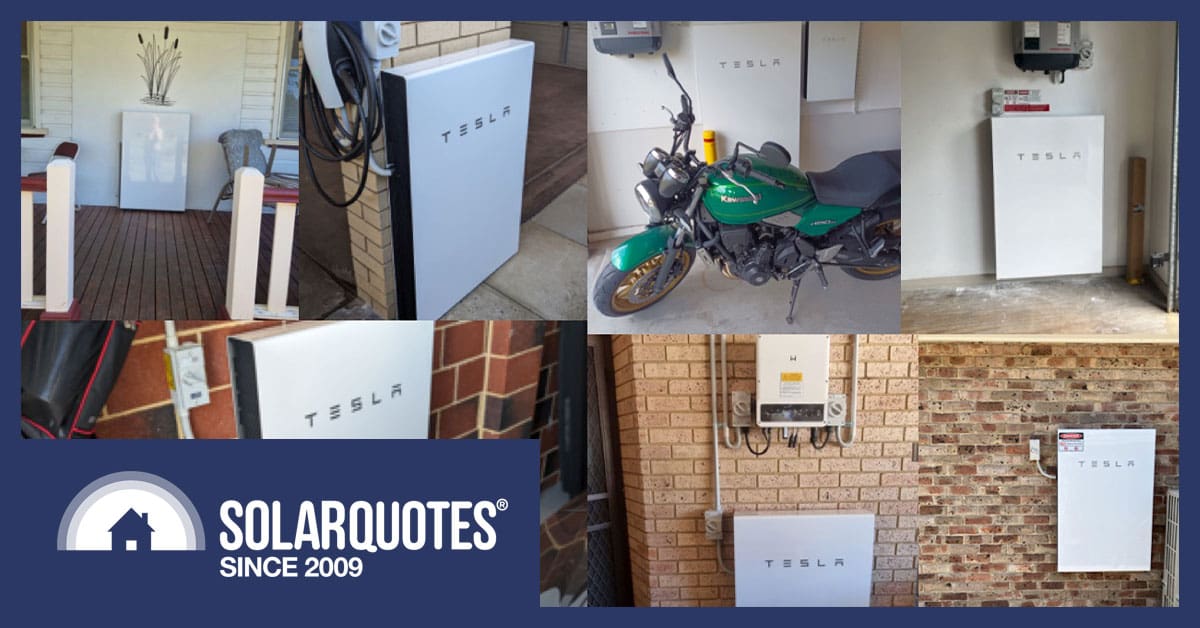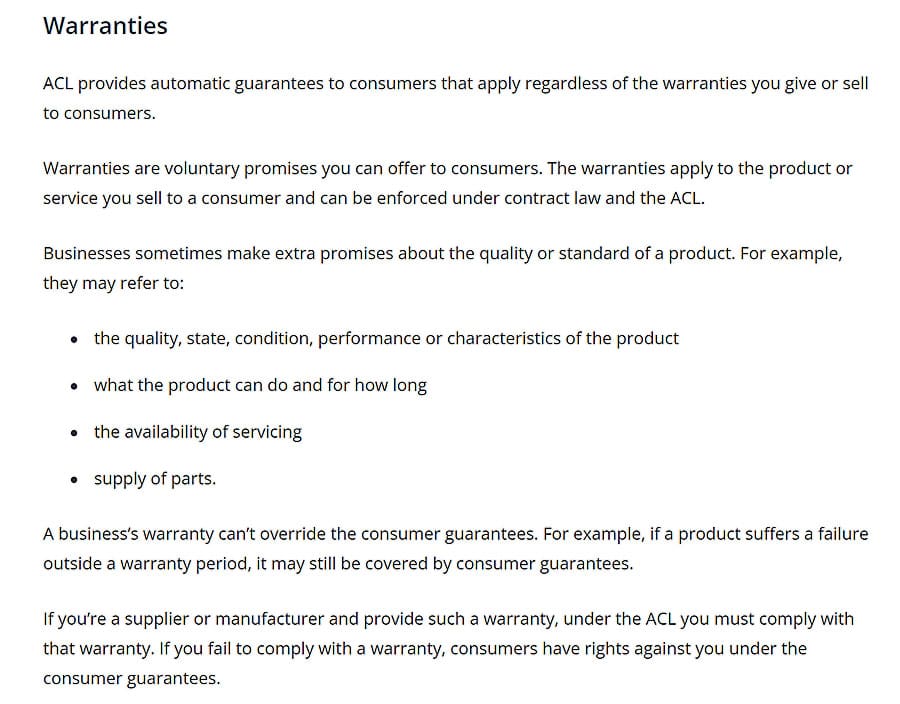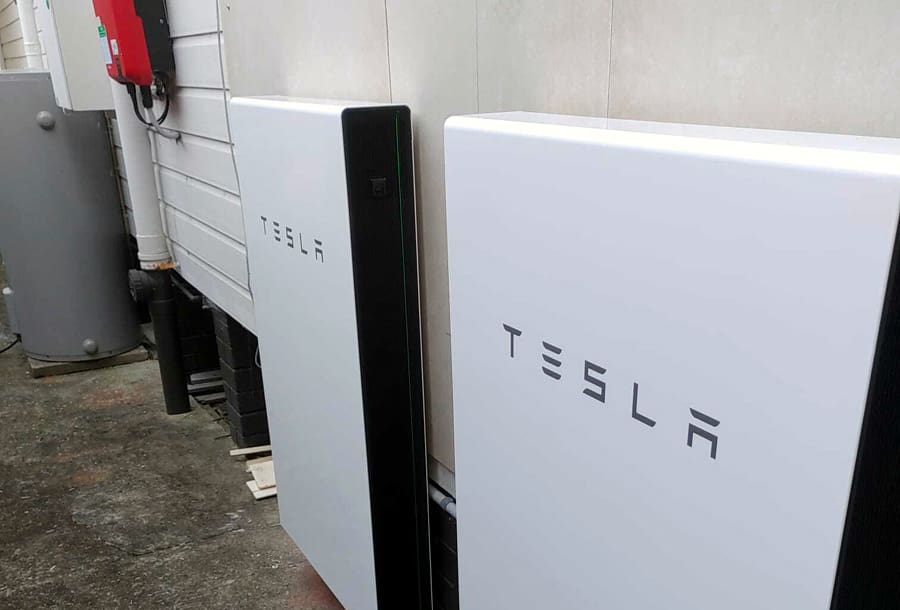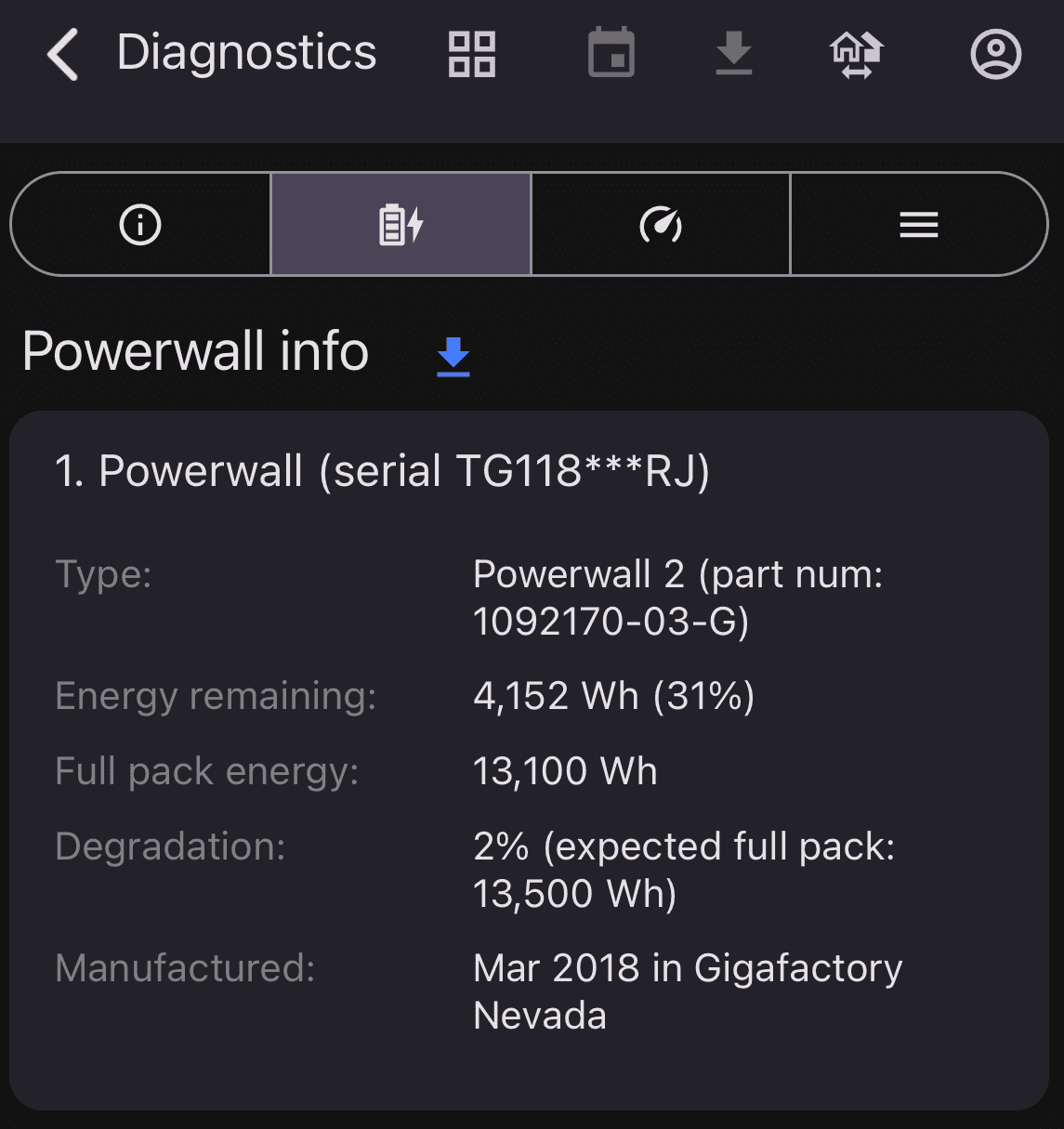
If your brand-new Powerwall falters, brace yourself for nothing more than a refurbished replacement from Tesla. At least that’s the experience SolarQuotes reader Joe had when his Powerwall stopped working two months after being installed.
To add insult to injury, the refurbished battery had a significantly reduced capacity compared to the original one. Joe wouldn’t have a bar of it, and after being drawn into an unwanted battle with Tesla, he managed to get a more suitable replacement.
Tesla’s Powerwall Warranty
Listen up, Powerwall owners; it’s time to check your paperwork! Did you know the Tesla Powerwall warranty states:
“A Powerwall presented for repair may be replaced by a refurbished Powerwall of the same type”
That sounds a bit crap, but don’t despair. It also says:
“Tesla will, at its own discretion, either repair your Powerwall, replace your Powerwall with an equivalent product, or refund you the market price of an equivalent product at the time of the warranty claim.”
So, by Tesla’s warranty, you’d expect an “equivalent product” to be at least equal to the original product.
But what if the original Powerwall Tesla delivered had more capacity that the 13.5 kWh promised in Tesla’s specs? Should Tesla’s replacement match the bigger capacity or are they only obligated to match their paper spec?
How Joe’s Powerwall Went From Hero To Zero
Last July, Joe used SolarQuotes free ‘Get 3 Quotes‘ service to enquire about installing two Tesla Powerwall batteries. He proceeded with one of the quotes, and installation occurred about a month later. He was very impressed with the installer.
Only two months later, one of his solar batteries failed. Joe contacted the installer, who then came to check it out. Due to a communications issue, the system wasn’t picking up the second battery. He tested all the comms cables, changed the terminal block and re-terminated the wiring, but an error message continued to appear. The installer tried multiple times to call Tesla tech support but never received a callback, so then shot them an email.
The next day, Tesla support emailed back that they had tried to retrieve data from Joe’s Powerwall remotely, with no luck. They suspected a sensor issue and were kickstarting the warranty process. The installer was quite surprised, as this was the first time one of his installed Powerwalls needed replacing. Up until then, they appeared to be bulletproof.
Unbeknownst to Joe, Tesla arranged to have the batteries switched out with a different installer. Everything went smoothly, and all was done less than two weeks after he’d raised the issue. And that’s really when the story starts.
The Refurbished Battery Discovery
It took only a short time for Joe to realise that the replacement battery had a lower capacity than his other, still working, original battery. When logging into the Gateway and making the appropriate API request, the system reported a nominal full-pack energy of 13.9 kWh in the replaced unit compared to 14.9 kWh in his original Powerwall.
Joe queried this with his original installer, who was still providing help, asking why the supposedly brand-new replaced Powerwall would have a lower capacity than the original battery. The installer immediately contacted Tesla, posing the same question and prompting them to investigate it.
Nine days later, Tesla Support emailed back that they guaranteed 13.5 kWh of energy out of the box, and both batteries are above the 13.5 kWh. Although a refurbished replacement battery is expected to have degraded more than a new one, it’s still above 13.5 kWh, and asked, “Can you tell how the customer is seeing the new battery is under 13.5 kWh?”
Joe’s installer relayed this information, alluding to the reality that he might have to wait until the battery capacity was below 13.5 kWh to make his next move. Joe was furious that Tesla had given him an inferior refurbished battery to replace his brand-new Powerwall without being told. However, he realised that a persistent, pragmatic approach was needed to get a just outcome.

Tesla Powerwall 2 warranty states that they will replace your Powerwall with an equivalent product, which may be refurbished. But, a refurbished battery doesn’t sound equivalent to a two-month-old battery to me.
13.5 kWh And Falling
Over the next six weeks, Joe monitored the capacities of both batteries, and it was only a short time before the battery in question had degraded below the magic 13.5 kWh. Since the installation of the refurbished Powerwall, the capacity of his original battery remained virtually unchanged, while the replacement’s capacity had dropped by more than 5%. It was now 2% below the 13.5 kWh nameplate capacity that Tesla guarantees.
Refurbished Powerwall
- On the day of refurbished install: Full pack energy 13,988 Wh
- Six weeks later: Full pack energy 13,263 Wh
Original Powerwall
- On the day of refurbished install: Full pack energy 14,929 Wh
- Six weeks later: Full pack energy 14,926 Wh
The Battle Begins
Now armed with this data, Joe wrote directly to Tesla Support, with his installer CC’d. He conveyed his latest findings eloquently and requested a proper replacement, “that was equivalent to the item that I had purchased only a few weeks earlier.”
The installer, who was very supportive, chimed into the conversation, letting everyone know that if Joe’s latest attempt to get a suitable replacement was approved, he had some batteries in stock and could install one as soon as possible.
Unbelievably, Tesla Support stubbornly wrote back, telling the installer they couldn’t give the green light to go ahead. They said that even though the battery capacity was now about 13.3 kWh, it was over 13.5 kWh on the installation date!
They attached the warranty document, highlighting the text:
“Your Powerwall will have an energy capacity of 13.5 kWh on its initial installation date and will retain energy capacity of 70% at ten years following the initial installation date.”
Joe was fully amped up now, and the gloves were off. In his reply, he told them that their so-called warranty was not relevant when we have Consumer Guarantees in Australia that cannot be overridden:
“Your response only mentions the warranty, which is a voluntary promise made by Tesla with respect to the long-term performance of a Powerwall battery… Tesla’s warranty is of no relevance in this matter. What is relevant is Tesla’s responsibility to adhere to Australian Consumer Law by supplying a replacement for the product I purchased, which is of the same level of quality and capability as the original. It is clear that this isn’t the case. As such, I request again that Tesla provide a brand new battery to replace the existing refurbished battery.”

Consumer Guarantees Factsheet – warranties for businesses. Warranties are voluntary promises vendors can offer to consumers.
Persistence Pays off For Joe
Tesla Support sat on this for a couple of days, then replied dismissively,
“Tesla has the option to supply either a refurbished Powerwall or an identical one. Please review page [blah blah blah] of the warranty document for clarification.”
This was followed with the patronising comment,
“I’ll consult with management to see what we can do.”
Joe was tired of this bullshit and replied by re-iterating the points in his previous emails and letting them know that “if this does not provide the outcome that I am seeking, then I will commence steps to seek input and support from the relevant NSW consumer protection authorities.”
To cut a long story short, this extra prodding by Joe worked. His warranty claim was escalated up the chain of command, and after a further week’s worth of to-ing and fro-ing, he received confirmation that Tesla would replace his battery with a new one. He now has a brand-new Powerwall happily humming along next to his original one. These are the full-pack energy readings:
New replacement Powerwall
- On the day of the new install: Full pack energy 14577 Wh
- As of the time of writing: Full pack energy 14280 Wh
Original Powerwall
- On the day of the new install: Full pack energy 14919 Wh
- As of the time of writing: Full pack energy 14726 Wh

Joe’s two Powerwalls, now happily humming along side by side. Aww don’t they look cute?
Tesla’s Transparency Is Eroding
Some Powerwall owners have reported no longer seeing their battery full-pack energy using the API through the Tesla Gateway. Sometime during the last firmware update, this function quietly disappeared. It looks like Tesla was hoping nobody would notice, but plenty of people sure have!
It certainly throws up a red flag regarding Tesla’s transparency, given that Joe’s ability to monitor his batteries was the foundation of his warranty claim.
Touché Tesla, but the game isn’t over yet. There are still multiple ways to check a Powerwall’s capacity:
1) Download this third-party app Netzero for Tesla. “Monitor and optimise your energy system with a single-screen display, Powerwall degradation tracking, solar generation analysis, Emporia energy monitor support, and more!”
2) Download SolarQuotes’ DIY Battery Health Estimator and do it yourself! This method is clunky, but being a bit more of a hands-on approach, it allows the user to understand their charging and discharging cycles better. It’s also possible to use this on other battery brands.
Note from Finn: I tried this just now – NetZeroApp says my 6 year old Powerwall is sitting at 13.1 kWh. Kim’s Battery Health spreadsheet estimated 12.7 kWh capacity was left.
Tesla’s Customer Service Challenge
Readers, don’t get me wrong. In some instances, Tesla’s use of refurbished batteries for warranty replacements is a legitimate practice. For example, if your battery was a few years old before it gave up the ghost, it would be perfectly acceptable to be offered a suitable refurbished battery as a replacement.
In Joe’s experience, however, in not offering a brand-new battery to replace his failed, 2-month-old Powerwall, Tesla fell short of their usual Australian customer service standards.


 RSS - Posts
RSS - Posts



I will be going through this.. After nearly 4 years my Powerwall 2 has lost 24%, its at 76% now. Tesla won’t do anything until the battery is under 70%.
I honestly believe when your battery is at this level, it’s not “fit for purpose” you have lost a 1/4 of its capacity in a short time.
Great read, thanks Kim & Finn.
Joe good work, this site demonstrates again the high value of swapping notes on a relevant and considered format.
A great platform for the private power generators across this country.
Cheers Kel
Dumb question, but how do you test capacity in the NetZero app? Just installed it and it’s working fine, wasn’t sure where the capacity reading was though. May have had a man’s look 😉
I’ll probably see it the moment I hit send…
Got it!
Guess I should be happy that full pack energy is showing as 14,708 Wh after a year of operation.
Thanks Finn.
On Net Zero, when I select that drop down menu the option is Gateway Diagnostics, when I select that it asks you to select between Configure Manually or Reset Configuration or Close?
Hit ‘Configure Manually’ and follow the instructions from there.
Netzero app author here: in the latest version of the app, I added a basic version of the Diagnostics screen that shows Powerwall degradation across all batteries. That way you don’t need to connect to the gateway directly (which is a somewhat more error-prone process).
Hope this helps and thanks for using the app!
Interesting reading. My three year old Powerwall 11 failed on Christmas Eve, so no chance of any action until early January when my installer returned to work. To his credit he was on the case to Tesla within 24 hours. Tesla checked it remotely and responded within another 24 hours advising that my battery would be replaced. Within a week the new battery arrived in the installer’s warehouse (in another town) and it was installed the same day.
Seems I need to download one of the apps referred to above to check my battery capacity; I know when I plug in the loan EV it drags it down to the cutoff way before the car battery is fully charged!
The free Windows version of the “POWERWALL COMPANION” app has recently started to display the current battery capacity. Our PW2 was installed in August 2017 and has had a fairly easy life until lately when we joined the Amber system with Ausgrid’s two way tariff trial, which means it is discharged to the reserve level and recharged daily. Today the COMPANION app says it has 12.74kWh capacity.
Another Joe here another fail. I’m at 70 percent now. I logged a call in the new year about the degradation and still pulling teeth trying to get a replacement under warranty. The installer has been hopeless to deal with even though Tesla have acknowledged the issue and would like to replace the existing unit. I guess I need to send a few more emails and make some more phone calls.
All in all it hasn’t been a smooth process even though the installer and Tesla have acknowledged the issue at hand.
ACL also has a statement around “major failures”, which is a failure if the consumer had known about at the time of purchase they wouldn’t have bought it. For a major failure it’s the consumer’s choice whether to opt for repair, replacement or refund! Tesla warranty appears to contradict ACL
Hi Joe
Great article on Tesla’s stance on replacing batteries and how difficult it may be in dealing with them.
I have been delaying the purchase of my new Tesla battery and I’m wondering if that is the best battery for me. Can you suggest a couple of other battery suppliers with better service that I should consider?
Regards
Peter
PS Articles like this are priceless.
I’m glad I am using LIFEPO4 cells, that appear to be retaining capacity well. Well done Joe, for your persistence. I presume Tesla have not adopted LIFEPO4 yet.
Does Netzero or Battery DYI health monitor work OK on a desktop PC using Windows 10?
Hi Dave. Yes and yes. NetZero for Tesla has a web app, and the DIY battery health monitor is just an excel file that you can edit.
Thanks Kim,
The web use of Netzero on my Windows 10 desktop has everything except diagnostics.
It appears to have everything else which is very useful, although I was mainly keen to check the battery status including degradation.
Any ideas on this?
Thanks,
Dave
Yes. Buy a smartphone.
Update Dave – the NetZero app author read your comment and has just added a basic version of the Diagnostics screen to the web app.
I was of the understanding that if an item is replaced totally, it should be a new item, otherwise the original item can be repaired. Have the consumer laws changed since I worked at Choice some 50 years ago?
Hi Doug. I don’t know if consumer laws have changed since you worked for Choice 50 years ago, but here’s a link to the actual law dated 14 years ago…
https://www.cbos.tas.gov.au/__data/assets/pdf_file/0006/408255/ACL_Schedule_2.pdf
It’s good thing that you’ve retired because, given the length of this document, it may take a while to find your answer. My guess is that the wording is slightly ambiguous. I did a keyword search and I don’t think it mentions the word ‘new’ in that context. Let me know what you come up with.
Netzero app author here: I just added a basic version of the Diagnostics screen to the web app.
The more detailed diagnostics are unfortunately not easy to get from a web browser, since they require direct connection to your gateway.
Thank you Ziga.
Wonderful, thank you so much. And I discovered 0% degradation in over a year of use, and also that they shipped the Powerwall with over 1.2 kWh more than advertised, so a a happy camper here.
Hi Ziga
I have been using your app for a month or so and all was well until a week or so ago. It seems there was an update to the app. Now I am still able to look at the basic data but I have lost access to the diagnostics and can’t work out how to connect to look at the diagnostics again.
Hi Alan,
Tesla unfortunately removed one of the ways to access battery capacity data, so a gateway connection is now required to get the data. If you’re having trouble with connecting to the gateway, please email [email protected] and I can help investigate.
To add to this well researched blog,
1. Powerwall Companion as from 2 days ago does not show the Powerwall 2 Capacity because the data isn’t available.
2. Another user has reported today, that Home Assist no longer provides the data.
3. NetZero is still working and Ziga has added the decimal point. This came to fore with another user who was showing 29%, which became 29.9% after the App was upgraded, and success with a replacement under warranty.
Today I rang Powerwall Support to find out what Powerwall 2 Part number 1457844-23-G.was. No comment from Powerwall Support, they will only talk to the user of that Part Number PW2. It shows on some of the replaced Powerwall 2’s under warranty.. Also there is no Manufactured data. I can only assume it’s a refurbished Powerwall 2
I posted earlier and my degrading Powerwall 2 was at 24% and has now flat lined and sitting at 24.1%. Thanks NetZero….
Tesla contacted me in August 2022, telling me the PW2 was degrading and asked me to contact them annually.. In that 1st 2.5 years the PW2 degraded @ 8.8%pa. Now magically, has degraded at 1.81%pa and 1,48%pa.respectively. In the last 6 months gained 0.01%. This PW2 was from the July 2019 Nevada batch which a few Australian users have posted about. So we wait.
Thanks to Ziga and his excellent Netzero App I’m in the same boat!
I found that my Powerwall II has 30% degradation.
After the Tier 2 (no) support from Tesla I’m currently in the process of trying to educate them on Australian Consumer Law and have stated that I think mine fails the ACL requirements on at least three fronts…
1) Acceptable quality – Shouldn’t have failed so quick
2) Fit for purpose – Doesn’t save as much money as they advertised it would
3) Major failure – I (a ‘reasonable consumer’) wouldn’t have bought it if I had of known it was going to degrade so quickly.
My installer was really good when the whole system was installed and I think he’s probably in the top two or three in my State so I don’t really want to go a ‘Consumer Affairs’ or, even worse “A current Affair ☺” on him……
Just yet!
Tesla replied that they are happy with the performance of my Powerwall and consider my Powerwall is operating in accordance with their warranty standards with no comment on my suggestion that they need to abide by Australian Consumer Law.
Off to the ACCC and my state Consumer Affairs!
As posted earlier I have the dreaded July 2019 PW2, fortunately with 2 other PW2’s with minimal loss, I’m not affected. I’m concerned what I believe could be Tesla Management of the “bad” PW2’s as mentioned by a UK user in their Tesla Powerwall FB Group.
Now we are 4.4 years with the bad PW2, it’s progress was 24% degrade in the the first 2 years, and, only 1.1% in the next 2.5 years. a remarkable recovery.. Also when you see that Tesla now have extra capacity in reserve over our 13,500wH of about 10% instead of the 5% when we purchased. When you consider Tesla contacted me in Aug’22 asking me to check with them every year. At the current rate of loss it will get to 30% at 10 years.
For those with a single PW2 I get concerned for their loss of usable capacity.
I finally went to the Victorian Consumer Affairs a month ago and no success there because they base their findings on known outcomes. My complaint has been closed and they suggested I go to VCAT and get a ruling. At least they rang me and discussed the issue.
I have an Excel spreadsheet of the degradation showing all 3 PW2’s and cannot upload an image to include in this post.